
The Thomisidae are a family of spiders, including about 170 genera and over 2,100 species. The common name crab spider is often linked to species in this family, but is also applied loosely to many other families of spiders. Many members of this family are also known as flower spiders or flower crab spiders.

Wolf spiders are members of the family Lycosidae. They are robust and agile hunters with excellent eyesight. They live mostly in solitude, hunt alone, and usually do not spin webs. Some are opportunistic hunters, pouncing upon prey as they find it or chasing it over short distances; others wait for passing prey in or near the mouth of a burrow.
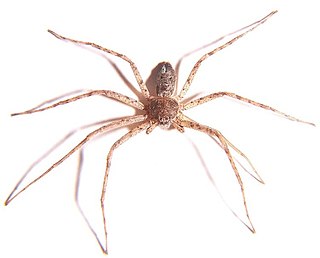
Philodromidae, also known as philodromid crab spiders and running crab spiders, is a family of araneomorph spiders first described by Tord Tamerlan Teodor Thorell in 1870. It contains over 500 species in thirty genera.

Leucorchestris arenicola, commonly called the dancing white lady spider, is a huntsman spider in the family Sparassidae and genus Leucorchestris. It is commonly found in the Namib desert of Namibia. It is often mistaken with the similarly named Carparachne aureoflava, or more commonly known as the wheel spider from the same location. L. arenicola relies on seismic vibrations, called drumming, for communication. It taps its foremost legs on the sand to send messages to other white lady spiders. Male L. arenicola will travel over 50 m in one night searching for a mate. If they find a mate, they must be extremely careful, for drumming the wrong message can be deadly. One of the major features that characterizes its nocturnal behavior is its specialized vision, using eight eyes in different orientations to capture a panoramic view of the surroundings. L. arenicola spiders use temporal summation in order to be able to see dim lighting during night-time wanderings. The species was first described by Reginald Frederick Lawrence in 1962, who described all the species in the genus Leucorchestris.

Zoropsidae, also known as false wolf spiders for their physical similarity to wolf spiders, is a family of cribellate araneomorph spiders first described by Philipp Bertkau in 1882. They can be distinguished from wolf spiders by their two rows of eyes that are more equal in size than those of Lycosidae.
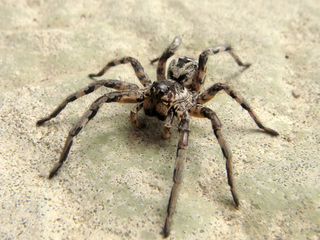
Lycosa tarantula is the species originally known as the tarantula, a name that nowadays in English commonly refers to spiders in another family entirely, the Theraphosidae. It now may be better called the tarantula wolf spider, being in the wolf spider family, the Lycosidae. L. tarantula is a large species found in southern Europe, especially in the Apulia region of Italy and near the city of Taranto, from which it gets its name.
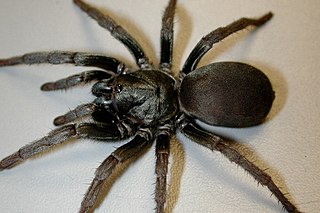
Nemesiidae, also known as funnel-web trapdoor spiders, is a family of mygalomorph spiders first described by Eugène Simon in 1889, and raised to family status in 1985. Before becoming its own family, it was considered part of "Dipluridae".

The Kauaʻi cave wolf spider, also known to local residents as the blind spider, is only known to occur in a few caves in a lava flow with an area of 10.5 km2 (4.1 sq mi) in the Kōloa–Poʻipū region of Kauaʻi, Hawaiian Islands, and only six populations are known to exist. While their nearest surface-dwelling relatives have large eyes, this species has completely lost its eyes. They reach a body length around 20 mm (0.8 in), and are reddish brown and completely harmless to people. Unlike most wolf spiders, it produces only 15 to 30 eggs per clutch. The female carries the egg sac in her mouthparts until the spiderlings hatch.

Sexual cannibalism is when an animal, usually the female, cannibalizes its mate prior to, during, or after copulation. It is a trait observed in many arachnid orders, several insect and crustacean clades, and some snake species. Several hypotheses to explain this seemingly paradoxical behavior have been proposed. The adaptive foraging hypothesis, aggressive spillover hypothesis and mistaken identity hypothesis are among the proposed hypotheses to explain how sexual cannibalism evolved. This behavior is believed to have evolved as a manifestation of sexual conflict, occurring when the reproductive interests of males and females differ. In many species that exhibit sexual cannibalism, the female consumes the male upon detection. Females of cannibalistic species are generally hostile and unwilling to mate; thus many males of these species have developed adaptive behaviors to counteract female aggression.
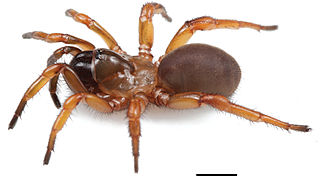
Myrmekiaphila is a genus of North American mygalomorph trapdoor spiders in the family Euctenizidae, and was first described by G. F. Atkinson in 1886. All described species are endemic to the southeastern United States.
Zygoballus melloleitaoi is a species of jumping spider which occurs in Argentina. It is known only from a single female specimen collected in Puerto Victoria, Misiones.

Hogna carolinensis, commonly known as the Carolina wolf spider and giant wolf spider, is found across North America. It is the largest of the wolf spiders in North America, typically measuring at 18–20 mm for males and 22–35 mm for females.
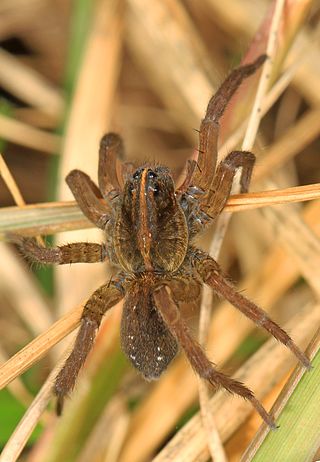
Tigrosa helluo is a species of spider belonging to the family Lycosidae, also known as wolf spiders. T. helluo was formerly known as Hogna helluo before differences between dorsal color patterns, habitat preferences, body structures, etc. were discovered. The species is native to the United States, Canada, and Mexico. It can be found across the eastern half of the United States, primarily in the Northeast and New England, and as far west as Nebraska and Kansas. T. helluo can be found in diverse habitats including woods, marshes, fields, and riparian areas. Typically, members of this species prefer to live in wetter areas as opposed to dry environments. Males tend to live for around a year and females will live for close to two years.

Mastophora, also known as bolas spiders, is a genus of orb-weaver spiders first described by E. L. Holmberg in 1876. They can be identified by a pair of lumps on the dorsal surface of the opisthosoma, though not all males will have these lumps.
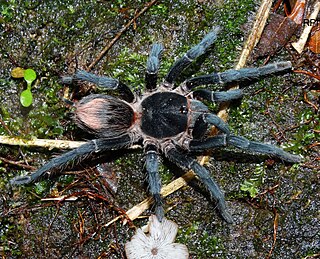
Homoeomma is a genus of South American tarantulas that was first described by Anton Ausserer in 1871. It is considered a senior synonym of Calopelma, Butantania, and of Cyclothoracoides. These tarantulas are usually quite small and usually burrow a few centimeters under a rock or log.

Geolycosa is a genus of wolf spiders first described in 1904.

Rhomphaea is a genus of comb-footed spiders that was first described by Ludwig Carl Christian Koch in 1872.
Schizocosa stridulans is a sibling species of S. ocreata and S. rovneri and is part of the wolf spider family. The name of the genus comes from the epigynum structure being lycosid and having a split T excavation. This spider is well-known for its specific leg ornamentation and courtship rituals and that is how it has been differentiated from its related species. The S. stridulans take systematic steps during its courtship ritual, which involves two independent signals. More specifically, female spiders will leave silk and pheromones to communicate that they are ready to mate.

Pardosa pseudoannulata, a member of a group of species referred to as wolf-spiders, is a non-web-building spider belonging to the family Lycosidae. P. pseudoannulata are wandering spiders that track and ambush prey and display sexual cannibalism. They are commonly encountered in farmlands across China and other East Asian countries. Their venom has properties that helps it function as an effective insecticide, and it is, therefore, a crucial pesticide control agent.

Allocosa subparva is a species of wolf spider in the family Lycosidae. They are found throughout western North America, as far north as Oregon to Idaho and as far south as Nayarit, Mexico.


















